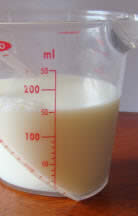Try these online games to practice your time telling skills :)
Large clock- to change the time in minutes/ half an hour and hour- to test your time reading skills
http://www.teachingtime.co.uk/clock/clockres.html
On Time- move the clock hands to the time written below
http://www.sheppardsoftware.com/mathgames/earlymath/on_time_game1.htm
Stop the clock- convert/ showing 24 hour time.
http://www.teachingtime.co.uk/draggames/sthec5.html
Bang on time- stop the clock at the right time written below
http://www.teachingtime.co.uk/clock2/clockwordsres.html
Clock Target- Match the clock time to the digital version
http://www.sheppardsoftware.com/mathgames/earlymath/clock_shoot.htm
Please press reply below if you find any games you like/ would like added to the blog.
Thursday, 12 December 2013
Thursday, 28 November 2013
Money- Budgets
What is a budget?
A budget is a money plan. It is like a blueprint of how much
money you earn and how and where you spend it.
Why should I budget?
Whether you have a lot of money or just a little, a budget can
help you in many ways:
If you have a budget and stick to it, you will be less likely to
blow your money during random daily spending.
A budget can help you reach a financial goal because it controls
how much you spend and how much you save.
Budgets can help eliminate many money surprises because you’ve
planned ahead and know what to expect each month.
Even though you’re young, you can start budgeting now to get
yourself into the habit.
Budgets help you see exactly where your money goes.
Tuesday, 19 November 2013
Types of conflict
• Character
versus character: The most popular, since conflicts between people are the most
interesting to readers. (Example: Cinderella and her wicked stepmother)
• Character
versus himself/herself: Conflict between good and evil or strengths and
weaknesses in a character. This is deep stuff and not usually the main
conflict. (Example: The Grinch is evil and hates Christmas, but he is not evil
at heart -- he is like that because someone hurt him. The Grinch feels inner
conflict over the good and evil inside of him.)
·
"Get the story going" event: Show character's problem & event that starts
adventure. (Shrek's swamp is ruined when Lord Farquaad puts fairy tale
creatures there. Lord Farquaad promises to remove the fairy tale creatures
after Shrek rescues Princess Fiona.)
·
Adventure scene(s): Meet friends & enemies, face obstacles, learn lessons, prepare
for...(Shrek meets Donkey, they rescue Princess Fiona and set off for Duloc.
Along the way, they become friends and have adventures, like fighting Robin
Hood and his Merry Men.)
·
THE BIG EVENT:
Everything is on the line. Most exciting part of story. (The wedding scene.)
·
Wrap-up: Tie up
the loose ends and hand out rewards & punishments. (Shrek marries Fiona,
Donkey falls in love with the dragon, and Farquaad is eaten by the dragon.)
• Character
versus nature: Usually involves natural disasters or survival skills. This
conflict is exciting, but often difficult to write about at length. (Example:
The character in Jurassic Park must survive in and escape from a dangerous land
of dinosaurs.)
Equivalent Fractions
Equivalent Fractions
Equivalent Fractions have the same value, even though they may look different.
These fractions are really the same:
| = |
| = |
|
The rule to remember is:
"Change the bottom using multiply or divide,
And the same to the top must be applied"
So, here is why those fractions are really the same:And the same to the top must be applied"
| × 2 | × 2 | |||
| 1 | = | 2 | = | 4 |
| 2 | 4 | 8 | ||
| × 2 | × 2 | |||
| 1/2 | 2/4 | 4/8 | ||
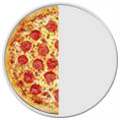 | = | 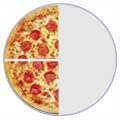 | = | 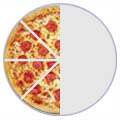 |
 | See the AnimationSee Fractions on the Number Line ... it shows you many equivalent fractionsWe also have a Chart of Fractions with many examples of equivalent fractions. |
Dividing
Here are some more equivalent fractions, this time by dividing:| ÷ 3 | ÷ 6 | |||
| 18 | = | 6 | = | 1 |
| 36 | 12 | 2 | ||
| ÷ 3 | ÷ 6 | |||
If we keep dividing until we can't go any further, then we have simplified the fraction (made it as simple as possible).
Summary:
- You can make equivalent fractions by multiplying or dividing both top and bottom by the same amount.
- You only multiply or divide, never add or subtract, to get an equivalent fraction.
- Only divide when the top and bottom would still be whole numbers.
Friday, 8 November 2013
Probability- Chance and Data
Probability
How likely something is to happen.
Many events can't be predicted with total certainty. The best we can say is how likely they are to happen, using the idea of probability. | Tossing a CoinWhen a coin is tossed, there are two possible outcomes:
And the probability of the coin landing T is ½. |
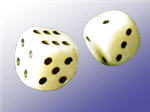 | Throwing DiceWhen a single die is thrown, there are six possible outcomes: 1, 2, 3, 4, 5, 6.The probability of any one of them is 1/6. |
Probability
In general:| Probability of an event happening = | Number of ways it can happen | |
| Total number of outcomes |
Example: the chances of rolling a "4" with a die
Number of ways it can happen: 1 (there is only 1 face with a "4" on it)Total number of outcomes: 6 (there are 6 faces altogether)
| So the probability = | 1 |
| 6 |
Example: there are 5 marbles in a bag: 4 are blue, and 1 is red. What is the probability that a blue marble will be picked?
Number of ways it can happen: 4 (there are 4 blues)Total number of outcomes: 5 (there are 5 marbles in total)
| So the probability = | 4 | = 0.8 |
| 5 |
Probability Line
You can show probability on a Probability Line: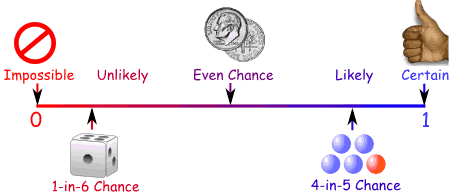
Probability is always between 0 and 1
Probability is Just a Guide
Probability does not tell us exactly what will happen, it is just a guideExample: toss a coin 100 times, how many Heads will come up?
Probability says that heads have a ½ chance, so we would expect 50 Heads.But when you actually try it out you might get 48 heads, or 55 heads ... or anything really, but in most cases it will be a number near 50.
Words
Some words have special meaning in Probability:
Experiment or Trial: an action where the result is uncertain.
Tossing a coin, throwing dice, seeing what pizza people choose are all examples of experiments.
Sample Space: all the possible outcomes of an experiment
Example: choosing a card from a deck
There are 52 cards in a deck (not including Jokers)
So the Sample Space is all 52 possible cards: {Ace of Hearts, 2 of Hearts, etc... }
The Sample Space is made up of Sample Points:There are 52 cards in a deck (not including Jokers)
So the Sample Space is all 52 possible cards: {Ace of Hearts, 2 of Hearts, etc... }
Sample Point: just one of the possible outcomes
Example: Deck of Cards
- the 5 of Clubs is a sample point
- the King of Hearts is a sample point
Event: a single result of an experiment
Example Events:
- Getting a Tail when tossing a coin is an event
- Rolling a "5" is an event.
- Choosing a "King" from a deck of cards (any of the 4 Kings) is an event
- Rolling an "even number" (2, 4 or 6) is also an event
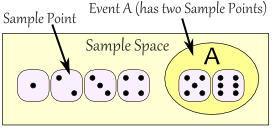 | The Sample Space is all possible outcomes. A Sample Point is just one possible outcome. And an Event can be one or more of the possible outcomes. |
Hey, let's use those words, so you get used to them:

Example: Alex decide to see how many times a "double" would come up when throwing 2 dice.
Each time Alex throws the 2 dice is an Experiment.It is an Experiment because the result is uncertain.
The Event Alex is looking for is a "double", where both dice have the same number. It is made up of these 6 Sample Points:
{1,1} {2,2} {3,3} {4,4} {5,5} and {6,6}
The Sample Space is all possible outcomes (36 Sample Points):
{1,1} {1,2} {1,3} {1,4} ... {6,3} {6,4} {6,5} {6,6}
These are Alex's Results:
| Experiment | Is it a Double? |
| {3,4} | No |
| {5,1} | No |
| {2,2} | Yes |
| {6,3} | No |
| ... | ... |
After 100 Experiments, Alex had 19 "double" Events ... is that close to what you would expect?
Source: http://www.mathsisfun.com/data/probability.html
Monday, 28 October 2013
Saturday, 21 September 2013
Holiday Homework - September Break
Wishing all my students a lovely holiday break.
For those that are in my homegroup and require my edmodo link and code for the Writing / Inquiry groups
Follow WRITING : edmo.do/j/zreuc4
Group code : ucbeg3
Inquiry link : edmo.do/j/7migxp
Group code: f7gqm3
It is expected that you complete the holiday homework and using the document on the inquiry edmodo- complete at least THREE research sessions and document this within the inquiry journal. Download this and then you can work directly into the document
Have a lovely break and I will see you all in Term 4 :)
For those that are in my homegroup and require my edmodo link and code for the Writing / Inquiry groups
Follow WRITING : edmo.do/j/zreuc4
Group code : ucbeg3
Inquiry link : edmo.do/j/7migxp
Group code: f7gqm3
It is expected that you complete the holiday homework and using the document on the inquiry edmodo- complete at least THREE research sessions and document this within the inquiry journal. Download this and then you can work directly into the document
Have a lovely break and I will see you all in Term 4 :)
Tuesday, 17 September 2013
Thursday, 12 September 2013
Padlet activity
Follow the links to add to your groups padlet wall..
You need to work on the task together. Please make sure you change the information into your own words and source (copy) the link/ website you used.
Blue: How does an egg beater work?
http://padlet.com/wall/ynislrks6c
Red: Why does it rain?
http://padlet.com/wall/76rv2wjwnk
Green: How does a bike work?
http://padlet.com/wall/wvpuf8w78l
Remembering ..................you must include the specifici/ technical or scientific language used as this will be needed when you write your own explanation piece on the topic.
You need to work on the task together. Please make sure you change the information into your own words and source (copy) the link/ website you used.
Blue: How does an egg beater work?
http://padlet.com/wall/ynislrks6c
Red: Why does it rain?
http://padlet.com/wall/76rv2wjwnk
Green: How does a bike work?
http://padlet.com/wall/wvpuf8w78l
Remembering ..................you must include the specifici/ technical or scientific language used as this will be needed when you write your own explanation piece on the topic.
Wednesday, 11 September 2013
From little things, big things grow
Listen to the following clip
http://www.youtube.com/watch?v=6_ndC07C2qw
What can you notice about the song?
This site http://www.abc.net.au/gnt/history/Transcripts/s1147120.htm may help you to understand/discuss the lyrics
Song lyrics- what do you notice about this? What do you not understand/ what can you then research? Please add your comments to this padlet.
Gather round people let me tell you're a story
An eight year long story of power and pride
British Lord Vestey and Vincent Lingiarri
Were opposite men on opposite sides
Vestey was fat with money and muscle
Beef was his business, broad was his door
Vincent was lean and spoke very little
He had no bank balance, hard dirt was his floor
From little things big things grow
From little things big things grow
Gurindji were working for nothing but rations
Where once they had gathered the wealth of the land
Daily the pressure got tighter and tighter
Gurindju decided they must make a stand
They picked up their swags and started off walking
At Wattie Creek they sat themselves down
Now it don't sound like much but it sure got tongues talking
Back at the homestead and then in the town
From little things big things grow
From little things big things grow
Vestey man said I'll double your wages
Seven quid a week you'll have in your hand
Vincent said uh-huh we're not talking about wages
We're sitting right here till we get our land
Vestey man roared and Vestey man thundered
You don't stand the chance of a cinder in snow
Vince said if we fall others are rising
From little things big things grow
From little things big things grow
Then Vincent Lingiarri boarded an aeroplane
Landed in Sydney, big city of lights
And daily he went round softly speaking his story
To all kinds of men from all walks of life
And Vincent sat down with big politicians
This affair they told him is a matter of state
Let us sort it out, your people are hungry
Vincent said no thanks, we know how to wait
From little things big things grow
From little things big things grow
Then Vincent Lingiarri returned in an aeroplane
Back to his country once more to sit down
And he told his people let the stars keep on turning
We have friends in the south, in the cities and towns
Eight years went by, eight long years of waiting
Till one day a tall stranger appeared in the land
And he came with lawyers and he came with great ceremony
And through Vincent's fingers poured a handful of sand
From little things big things grow
From little things big things grow
That was the story of Vincent Lingairri
But this is the story of something much more
How power and privilege can not move a people
Who know where they stand and stand in the law
From little things big things grow
From little things big things grow
From little things big things grow
From little things big things grow
We will discuss this tomorrow as well, however today I would like you to gather your thoughts regarding the song lyrics. Please add this to padlet wall.
http://padlet.com/wall/9px259r553
http://www.youtube.com/watch?v=6_ndC07C2qw
What can you notice about the song?
This site http://www.abc.net.au/gnt/history/Transcripts/s1147120.htm may help you to understand/discuss the lyrics
Song lyrics- what do you notice about this? What do you not understand/ what can you then research? Please add your comments to this padlet.
Gather round people let me tell you're a story
An eight year long story of power and pride
British Lord Vestey and Vincent Lingiarri
Were opposite men on opposite sides
Vestey was fat with money and muscle
Beef was his business, broad was his door
Vincent was lean and spoke very little
He had no bank balance, hard dirt was his floor
From little things big things grow
From little things big things grow
Gurindji were working for nothing but rations
Where once they had gathered the wealth of the land
Daily the pressure got tighter and tighter
Gurindju decided they must make a stand
They picked up their swags and started off walking
At Wattie Creek they sat themselves down
Now it don't sound like much but it sure got tongues talking
Back at the homestead and then in the town
From little things big things grow
From little things big things grow
Vestey man said I'll double your wages
Seven quid a week you'll have in your hand
Vincent said uh-huh we're not talking about wages
We're sitting right here till we get our land
Vestey man roared and Vestey man thundered
You don't stand the chance of a cinder in snow
Vince said if we fall others are rising
From little things big things grow
From little things big things grow
Then Vincent Lingiarri boarded an aeroplane
Landed in Sydney, big city of lights
And daily he went round softly speaking his story
To all kinds of men from all walks of life
And Vincent sat down with big politicians
This affair they told him is a matter of state
Let us sort it out, your people are hungry
Vincent said no thanks, we know how to wait
From little things big things grow
From little things big things grow
Then Vincent Lingiarri returned in an aeroplane
Back to his country once more to sit down
And he told his people let the stars keep on turning
We have friends in the south, in the cities and towns
Eight years went by, eight long years of waiting
Till one day a tall stranger appeared in the land
And he came with lawyers and he came with great ceremony
And through Vincent's fingers poured a handful of sand
From little things big things grow
From little things big things grow
That was the story of Vincent Lingairri
But this is the story of something much more
How power and privilege can not move a people
Who know where they stand and stand in the law
From little things big things grow
From little things big things grow
From little things big things grow
From little things big things grow
We will discuss this tomorrow as well, however today I would like you to gather your thoughts regarding the song lyrics. Please add this to padlet wall.
http://padlet.com/wall/9px259r553
Tuesday, 10 September 2013
Padlet Activity
Follow the links to add to your groups padlet wall..
You need to work on the task together. Please make sure you change the information into your own words and source (copy) the link/ website you used.
Blue: How does a bike pump work?
http://padlet.com/wall/wca18irifa
Red: Why do volcanoes errupt?
http://padlet.com/wall/16smu82p5g
Green: Why does popcorn pop?
http://padlet.com/wall/mscw6hs3hp
You need to work on the task together. Please make sure you change the information into your own words and source (copy) the link/ website you used.
Blue: How does a bike pump work?
http://padlet.com/wall/wca18irifa
Red: Why do volcanoes errupt?
http://padlet.com/wall/16smu82p5g
Green: Why does popcorn pop?
http://padlet.com/wall/mscw6hs3hp
Friday, 6 September 2013
Reading- Homework
Please follow URL and use group code to join reading group.
URL: edmo.do/j/y6x4cd
Group Code: xtyk3i
You should be reading every night.
URL: edmo.do/j/y6x4cd
Group Code: xtyk3i
You should be reading every night.
Thursday, 5 September 2013
Wednesday, 4 September 2013
Simon Crean- EDMODO task
Your task tonight for homework is to find me ONE interesting fact about Simon Crean and add it to the padlet wall
http://padlet.com/wall/4kr3zhtte2
http://padlet.com/wall/4kr3zhtte2
Tuesday, 3 September 2013
Inquiry- What organisations influence society?
Please add the the padlet wall.
The task is written on there for you
http://padlet.com/wall/b6oz7en2vl
The task is written on there for you
http://padlet.com/wall/b6oz7en2vl
Maths- Homework
Mathletics is now set up with tasks for you to complete.
Come and see me before school or at recess/ lunch if you need your password.
Come and see me before school or at recess/ lunch if you need your password.
Monday, 2 September 2013
Writing-Party invitation for a spider monkey who rides comets
Your task today is to write on the following topic: You can be as creative as you want in the display/ presentation of the invite ONCE you have written out the information needed
Friday, 30 August 2013
Ways in influence society
Below is a list of ways that you can influence society.
Start a petition
Write a letter to an MP
Write to a newspaper
Create a blog
Join or start an organisation to help your community
Start a petition
Write a letter to an MP
Write to a newspaper
Create a blog
Join or start an organisation to help your community
Who decides- online game
Who decide: Online Game https://www.vec.vic.gov.au/files/Whodecides/default.html
Maths- Capacity- Information and online games

The amount that something can hold.
Usually it means volume, such as milliliters (ml) or liters (l) in Metric, or pints or gallons in Imperial.
Example: "The bucket has a capacity of 9 liters"
Usually it means volume, such as milliliters (ml) or liters (l) in Metric, or pints or gallons in Imperial.
Example: "The bucket has a capacity of 9 liters"
Measuring Cups
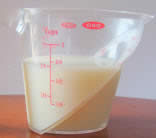
But there are also measuring cups, which are things used to measure liquids, or powders like flour or sugar.
As you fill up the measuring cup, you need to look at which number it is filled to.
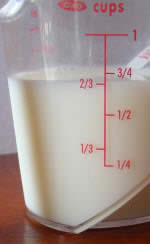
Here we have 2/3 cup (two-thirds of a cup) of milk.
Here we have 150 ml.
It doesn't say "150" ... it says "50" ... but it is half-way between 100 and 200 so you can figure out it is 150 ml.
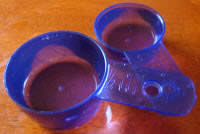
There are also special ones designed to hold an exact amount, such as these 1/2 cup and 1/4 cup measures.
Source: http://www.mathsisfun.com/measure/measuring-cups.html
Match it definitions: http://www.learninggamesforkids.com/math_games/3rd-grade-math/measurements-3rd/matchit-measurements-3rd.html
Vocabulary game: http://www.learninggamesforkids.com/math_games/3rd-grade-math/measurements-3rd/measurements-word-o-rama-3rd.html
Reading- Read Aloud
What we think it means to read aloud?
http://padlet.com/wall/b2o99oddmr
After listening to the following story 'The woodpeckers knock knock joke' , we had a disucssion about emotions/ characters when reading a story outloud.
http://www.mightybook.com/MightyBook_free/books/woodpecker_knocking/woodpecker_knocking.html
This is what we thought about the story
Blue/ Green Group: http://padlet.com/wall/5rzcuwr1e7
Red/ Purple Group: http://padlet.com/wall/n5npk5lgnk
http://padlet.com/wall/b2o99oddmr
After listening to the following story 'The woodpeckers knock knock joke' , we had a disucssion about emotions/ characters when reading a story outloud.
http://www.mightybook.com/MightyBook_free/books/woodpecker_knocking/woodpecker_knocking.html
This is what we thought about the story
Blue/ Green Group: http://padlet.com/wall/5rzcuwr1e7
Red/ Purple Group: http://padlet.com/wall/n5npk5lgnk
Thursday, 29 August 2013
Maths- Capacity
What do you know about capacity?
Capacity is how much 'something' can be held in an item?
Example: Water in a drink bottle
Amount of fans at the MCG
Today we will be looking at measuring capacity with mililitres/ litres.
Please begin with the worksheet, then complete the following game:http://www.abc.net.au/countusin/games/game15.htm
http://resources.woodlands-junior.kent.sch.uk/maths/measures/capacity.html#Capacity
Capacity is how much 'something' can be held in an item?
Example: Water in a drink bottle
Amount of fans at the MCG
Today we will be looking at measuring capacity with mililitres/ litres.
Please begin with the worksheet, then complete the following game:http://www.abc.net.au/countusin/games/game15.htm
http://resources.woodlands-junior.kent.sch.uk/maths/measures/capacity.html#Capacity
Wednesday, 28 August 2013
Maths- Homework
Please follow link to following edmodo page and use group code below to join the homework group for mathematics.
Website: edmo.do/j/j7vj4y
Code: 8wntnd
Website: edmo.do/j/j7vj4y
Code: 8wntnd
Writing- Explanation text examples
Today your task is to research types of explanation texts.
Please comment and add links (websites) below
Please comment and add links (websites) below
Tuesday, 27 August 2013
Inquiry- Why do you have to be over the age of 18 to vote?
Your task today is to research and compile your facts/ information/ questions regarding why you have to be over the age of 18 to vote into the following padlet wall.
http://padlet.com/wall/pgq1oo36ud
http://padlet.com/wall/pgq1oo36ud
Monday, 26 August 2013
Inquiry- How do I influence society?- Homework
Please follow below URL and use group code to join the homework group set for inquiry studies.
URL: edmo.do/j/dqifa5
Code: jtqf5b
You will need to check this regularly and respond to homework tasks.
Thank you
Miss Morris
URL: edmo.do/j/dqifa5
Code: jtqf5b
You will need to check this regularly and respond to homework tasks.
Thank you
Miss Morris
Writing- Homework
Please follow the link and use the code below to join/ add the edmodo account set for homework for writing.
URL: edmo.do/j/zreuc4
Code: ucbeg3
You will need to check this for assignments and tasks set.
Thank you
Miss Morris
URL: edmo.do/j/zreuc4
Code: ucbeg3
You will need to check this for assignments and tasks set.
Thank you
Miss Morris
Friday, 23 August 2013
Friday 23rd August 2013
Your task today is to complete the task on the board
Then follow link to play the measurement game online.
You need to select the appropriate length and weight for the item
http://www.kidsmathgamesonline.com/geometry/measurement.html
Then follow link to play the measurement game online.
You need to select the appropriate length and weight for the item
http://www.kidsmathgamesonline.com/geometry/measurement.html
Monday, 5 August 2013
How to sneak a monster into your school
Your task today is to write a story/ procedural on how to sneak a monster into your school.
Be sure you think about disguising your monster.
What your monster looks like?
Is he/she big or small?
Fluffy or rough fur?
Any special talents/ skills
Be sure you think about disguising your monster.
What your monster looks like?
Is he/she big or small?
Fluffy or rough fur?
Any special talents/ skills
Monday, 29 July 2013
First 5/20 writing prompts
You are to select one of the 5 fun writing prompts to write on in today's lesson.
Remember to check your work once you have finished, underline words you may think are wrong in red and check these.
Be sure you also check for L- O-N-G sentences and your punctuation.
- Finish this sentence: My superpower is…
- Use at least five color words to write a poem titled “A Rainbow of Feelings.”
- Describe the grossest lunch you’ve ever eaten.
- Who is your evil twin? Write about the mischievous deeds that he/she has done today.
- What one thing are you an expert on? Fill one page with information about _________ (your expert topic).
Friday, 26 July 2013
Describe a day in the life of an old lawyer who discovers a talking frog
LI: To write a piece of writing describing a day in the life of an old lawyer who discovers a talking frog.
Think about where the lawyer lives?
How he met the talking frog?
What the talking frog looks/ sounds like?
What do they talk about?
How does the story end?
I would like you to think of the best descriptive words to use in this piece.
Remember, it can be published on the blog. Make sure you check your spelling and puntuation.
Wednesday, 24 July 2013
Procedural Writing Rubric
Following the pre test- in which students wrote own procedural on how to brush their teeth-.
A rubric was designed to allow students to self assess their own pre test/ procedural text and create writing goals.
Writing goals allow both the student and teacher to have a clear indication of what needs to be improved, promoting open discussion and collaboration between class members.
A rubric was designed to allow students to self assess their own pre test/ procedural text and create writing goals.
Writing goals allow both the student and teacher to have a clear indication of what needs to be improved, promoting open discussion and collaboration between class members.
Saturday, 20 July 2013
Mathematics- Measurement and Geometry- Length
Length
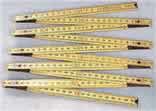 | Measuring how long things are, how tall they are, or how far apart they might be are all examples of length measurements. |
|

Small units of length are called millimeters.
A millimeter is about the thickness of a plastic id card (or credit card).
Or about the thickness of 10 sheets of paper on top of each other.
This is a very small measurement!
Centimeters
 |
When you have something that is 10 millimeters, it can be said that it is 1 centimeter.
1 centimeter = 10 millimeters
A fingernail is about one centimeter wide.
|
You might use centimeters to measure how tall you are, or how wide a table is, but you would not use it to measure the length of football field. In order to do that, you would switch to meters.
Meters
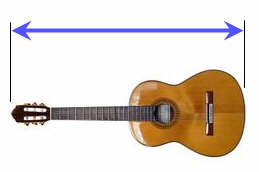 |
A meter is equal to 100 centimeters.
1 meter = 100 centimeters
The length of this guitar is about 1 meter
Meters might be used to measure the length of a house, or the size of a playground.
|
Kilometers
 |
When you need to get from one place to another, you will need to measure that distance using kilometers. A kilometer is equal to 1,000 meters.
The distance from one city to another or how far a plane travels would be measured using kilometers.
|
Final thoughts about measuring length:
1 centimeter = 10 millimeters
1 meter = 100 centimeters
1 kilometer = 1000 meters
Mathematics- Length- Online Games
Compare, order and measure length
Reading Length
Measurement Game
Easy, medium and hard centimeters
Easy, medium and hard inches
Longer or shorter
Friday, 19 July 2013
Writing- Writers Notebook
LI: To write
a story using the words below
Your first
task: To define the words below.
Desolate
Stifling
Transparent
Executive
Thursday, 18 July 2013
Wednesday, 17 July 2013
Writing- Procedural Text 2
Text 2: First, we are going to deconstruct the text together.
What do we notice about this text?
Add to comments below
Writing- Procedural Text 1
Text 1: First, we are going to deconstruct the text together.
What do we notice about this text?
Add to comments below
Thursday, 27 June 2013
Rhyme poems- continued
Today, our learning focus is the complete a rhyme poem, using more than one 'stanza'.
If you forget what a stanza is, check on the poem page of this blog
Once you have written your rhyme poem out in your book.
Please publish on this blog page.
So press, comments and add your rhyme poem in below :)
If you forget what a stanza is, check on the poem page of this blog
Once you have written your rhyme poem out in your book.
Please publish on this blog page.
So press, comments and add your rhyme poem in below :)
Poetry
Features of a Poem
There are several types of poems...For our unit in writing we have looked at:
Figurative language used in poems- metaphors/ similies/ onomotoeipia
We then looked at :
* I am Poems
* Haiku poems
* Cinquain Poems
* Rhyme Poems
Stanzas in Poetry
If you are looking towards poetry to find stanza examples you need not look far.
- Stanzas are available in even the first section of the poem.
- They are usually grouped together by the rhyme pattern and/or number of lines that they have.
In any given song you have perhaps unknowingly sung stanzas several times. They are known as the verses. Look at the lyrics of your favorite song carefully and you will easily notice the stanzas.
Types of Stanzas
There are many different types of stanzas. Some of which are:
- Couplets (stanza with two rhyming lines)
- Tercets (stanzas with three lines that may or may not rhyme)
- Quatrains (stanzas with four lines that may or may not rhyme)
Remember that in poetry you can identify a stanza by the number of lines that it has and its rhyme scheme or pattern.
Rhyme Poems
Poetry that rhymes relays a message through the music of the spoken word. Their power is in their ability to get us caught up in the music so that we will let down our defenses and consider the message that the poem has to offer. Sometimes poets use rhyme as a tool to show the humor in the message they are trying to convey. Traditional poems are written in rhyme to help to add a musical element to a reading. A rhyming poem brings out the joy that can be had in appreciating the music in words.
Source: Rhyme Poems - Poems which Rhyme http://www.familyfriendpoems.com/funny/rhyme-poems.asp#ixzz2XGmtDfFB
www.FamilyFriendPoems.com
A Funny Hamster Poem for Kids
From the book The Tighty-Whitey Spider
Source: Rhyme Poems - Poems which Rhyme http://www.familyfriendpoems.com/funny/rhyme-poems.asp#ixzz2XGmtDfFB
www.FamilyFriendPoems.com
My Hamster Has a Skateboard
A Funny Hamster Poem for Kids
From the book The Tighty-Whitey Spider

My hamster has a skateboard.
--Kenn NesbittWhen he rides it, though, he falls. He takes off like a maniac and crashes into walls. He screams, "Geronimo!" and then goes crashing down the stairs. He's good at knocking tables down and slamming into chairs. He'll slalom through the living room and then you'll hear a, "Splat!" which means that he's collided with my mother or the cat. He plows right into cabinets, and smashes into doors, I think he's wrecked on every bed and every chest of drawers. It's fun to watch him ride because you're sure to hear a smash. He doesn't skate so well but, boy, he sure knows how to crash. I'm Staying Home From School TodayA Funny School Poem for Kids From the book Revenge of the Lunch Ladies 
I'm staying home from school today.
I'd rather be in bed pretending that I have a pain that's pounding in my head. I'll say I have a stomach ache. I'll claim I've got the flu. I'll shiver like I'm cold and hold my breath until I'm blue. I'll fake a cough. I'll fake a sneeze. I'll say my throat is sore. If necessary I can throw a tantrum on the floor. I'm sure I'll get away with it. Of that, there's little doubt. But, even so, I really hope my students don't find out. --Kenn Nesbitt |
Wednesday, 26 June 2013
Concrete- Shape poems
Concrete poetry—sometimes also called ‘shape poetry’—is poetry whose visual appearance matches the topic of the poem. The words form shapes which illustrate the poem’s subject as a picture, as well as through their literal meaning.
Outline Poems
A common way to make the visual structure reflect the subject of the poem is to fill an outline shape that relates to the topic of the poem, in the same way that Carroll’s poem fits the outline of a mouse’s tail.
Here is an example about a snowman:

Another way to make concrete poetry is to use the lines of words to make the lines of a drawing. The NASA website has a great example about the first ever airplanes if you click here.
This time, the subject doesn’t have to be an object, but it does have to be something you can draw an illustration of using ‘stick’ figures.
This is my example of ‘growing’:

Try your own online :http://www.readwritethink.org/files/resources/interactives/theme_poems/
Outline Poems
A common way to make the visual structure reflect the subject of the poem is to fill an outline shape that relates to the topic of the poem, in the same way that Carroll’s poem fits the outline of a mouse’s tail.
Here is an example about a snowman:

- Choose an object to be the subject for your poem. Good suggestions for beginners could be favorite animals or favorite foods.
- Draw a simple outline of its shape on paper or on the computer. If you’re using paper, draw with a pencil not a pen.
- Write your poem normally. Try to describe how the subject makes you feel. The words will be fitted into your drawing, so don’t make it too long – between 6-12 lines is probably a good length!
IT DOESN’T HAVE TO RHYME!
- Lightly in pencil, or on the computer, write your poem into the shape. It’s ok if it doesn’t fit properly yet, because this is where you find out if you need to make the writing larger or smaller.
- Decide if you need to make your writing bigger or smaller in certain parts of the drawing, then erase your first draft and write out the poem again. You can keep doing this until you are happy.
- Finally, erase the outline of your shape, so that it is just the words from your poem left creating the image! If you were writing in pencil, you can now go over the words in pen!
- (In my example I added the ‘brrr…’s afterwards to make the picture look better, but without interrupting the story of the poem. If you want to try details like this, think of comic-book-style effect words like ‘flash’, ‘purr’, ‘phew’ or ‘zzzz…’ to add another element to the story-picture!)
Another way to make concrete poetry is to use the lines of words to make the lines of a drawing. The NASA website has a great example about the first ever airplanes if you click here.
This time, the subject doesn’t have to be an object, but it does have to be something you can draw an illustration of using ‘stick’ figures.
This is my example of ‘growing’:

- Choose your subject
- Draw a simple line – or ‘stick’ – drawing to illustrate your subject on paper or on the computer. If you’re using paper, draw with a pencil not a pen.
- Write your poem normally. Simple is best, so stick to between 2-6 lines.
IT DOESN’T HAVE TO RHYME!
- Lightly in pencil, or on the computer, write the lines of your poem along the lines of your drawing – remember that we normally read from left to right, and from top to bottom!
- If you don’t have enough words, or have some left over, don’t worry! Decide where you need to make your writing bigger or smaller to make it all fit, then erase your first draft and write out the poem again over your line drawing. You can keep doing this until you are happy.
- Finally, erase the line drawing, so that it is just the words from your poem left creating the image! (If you were writing in pencil, go over the writing in pen first.)
Try your own online :http://www.readwritethink.org/files/resources/interactives/theme_poems/
Subscribe to:
Comments (Atom)
